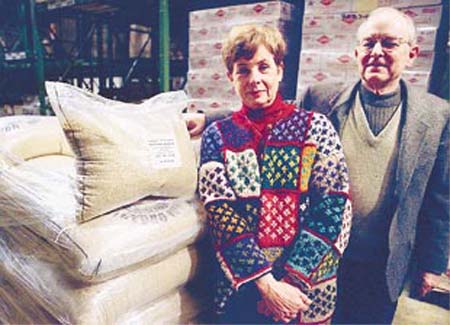
"I found out that they didn't have any nutritional problems, except for the fact that they didn't have money to buy food. Their diet was better than our diet; in fact, they changed my outlook on what is a good diet. "The Peace Corps had this saying that if you give a person a fish, you feed him for a day; if you teach him to fish, you feed them for a lifetime. Well, they already know how to fish. What they really need are markets."
"I had taught nutrition in the US and went down to Ecuador with the Peace Corps, thinking I was going to help the Ecuadorians with their nutritional problems," says Marjorie Leventry, who with her husband Bob owns a quinoa import business
Quinoa Comeback
Posted on: Saturday, 13 September 2008, 03:00 CDT
By Dobkin, Leah
A staple in Inca times, this nutritious, versatile "super food" is undergoing a resurgence in the Andes and beyond Five thousand years ago, the ancestors of the Inca people grew and ate a nutritious seed crop called quinoa. Although today it makes up only a tiny fraction of the worldwide whole-grain market, quinoa is experiencing tremendous growth in Europe, Canada, the Far East, Australia, New Zealand, and the United States. This growth has spawned new opportunities for farmers and villages in the Andes, where poverty rates are historically high and nutrition miserably low.
The Inca believed the crop to be sacred and referred to quinoa as chisaya mama, or "mother grain," because of its exceptional nutritional qualities. The protein content is very high and contains a balanced set of essential amino acids, making it an unusually complete vegetarian food. Quinoa is a good source of dietary fiber and phosphorus, and is high in magnesium, iron, Vitamin B6, Vitamin E, copper, and zinc. It is glutenfree and considered easy to digest.
Quinoa is actually not a grain, but a seed of the Chenopodium or goosefoot plant. The leaves look like a webbed foot of a goose. The plant grows from four to six feet high with large clusters of seeds at the end of a stalk. The seeds-small flattened spheres that look like sesame seeds-are ground into flour and substituted for grains. The leaves of the quinoa plant can also be eaten, like spinach.
There are more than 180 species of quinoa ranging in color from ivory to pink, brown to red, and almost black. Three varieties are mainly cultivated: white, dark red, and black. However, quinoa importers are mixing many varieties to maximize taste and visual appeal and preserve biodiversity for a healthier food supply.
Quinoa grows most successfully in cool, dry temperate regions at high elevations-between 6,000 and 11,000 feet-near the equator, where days and nights are of roughly equal length. It is resistant to drought and receptive to fertilizer.
A 400-year decline in the production of quinoa began with the Spanish conquest in the 1500s. While the Spanish colonists, scorned quinoa as "food for Indians," they felt threatened by this nutrition source as well. Quinoa was used to strengthen Inca armies while they marched for many days eating a mixture of quinoa and fat, known as "war balls." The Spanish destroyed quinoa fields in an attempt to weaken and conquer the population.
In more recent times, the ruling class told indigenous people that quinoa was not good for human consumption and should only be used as animal feed. The irony is that quinoa had literally gone underground and almost disappeared as malnutrition and poverty soared among the indigenous population in this region.
However, quinoa has been rediscovered. Paratroopers in World War II used it as a portable "super food." In the United States, it was first introduced commercially in 1982 and since then a handful of other importers have jumped onto the bandwagon. The National Aeronautics and Space Administration (NASA) is considering quinoa as a possible crop for long-duration manned spaceflights. Most imports come from small farmers high in the Andes in Bolivia, Peru, and Ecuador, with Bolivia exporting significantly larger amounts. Quinoa is also grown in Canada and the United States, but with minimal success.
Perhaps most significant to the rediscovery of this food source is that the descendents of the Inca are not only growing and selling quinoa but consuming it as well. It's been a long time coming, but quinoa has once again become a staple of indigenous peoples and an important source of income for local farmers and communities.
Pablo Laguna, who helped develop the Fairtrade Labelling Organization's (FLO) international quinoa standards in 2004, says quinoa farming has improved education as well as housing conditions. "This trade is not only helping farmers produce crops, but it helps create other businesses as well, such as small factories, artisans, mechanical services, and transportation," Laguna says.
According to a study by the People's Educational Radio of Ecuador (ERPE), a nonprofit foundation that groups together various campesino cooperatives, malnutrition has dropped dramatically-from some 74 percent in 1998 to less than 20 percent today-among children who live in the areas of quinoa cultivation. The study attributes this is in large part to the cooperatives' requirement that the indigenous farmers put up only two-thirds of their quinoa for sale and feed one-third to their families.
"I had taught nutrition in the US and went down to Ecuador with the Peace Corps, thinking I was going to help the Ecuadorians with their nutritional problems," says Marjorie Leventry, who with her husband Bob owns a quinoa import business. "I found out that they didn't have any nutritional problems, except for the fact that they didn't have money to buy food. Their diet was better than our diet; in fact, they changed my outlook on what is a good diet.
"The Peace Corps had this saying that if you give a person a fish, you feed him for a day; if you teach him to fish, you feed them for a lifetime. Well, they already know how to fish. What they really need are markets."
Quinoa has grown in popularity because of its combination of good taste, ease of use, and versatility. Cooked quinoa is used in baked goods, casseroles, soups, stews, stir-fries, salads, side dishes, desserts, breakfast cereals, and health bars. In the Andean countries and beyond, a growing number of high-end restaurants offer gourmet quinoa dishes on their menus.
But perhaps the real growth in quinoa is due to the growing demand for gluten-free, organic, and whole grains. The quinoa seed, when used as a grain substitute, has a fluffy, creamy, slightly crunchy texture and a nutty flavor when cooked. Quinoa flour is used in making pancakes, bread, muffins, pastas, crackers, and other foods. Quinoa seeds can be sprouted and eaten raw. The plant is sometimes grown as a green vegetable, and the leaves are eaten fresh or cooked.
In the United States, quinoa can be found in local health food stores or online. The best deal for consumers is to buy it in bulk at health food stores, where often costs are minimized because the health food store buys directly from the importer, skipping the distributor and wholesaler.
"It's a growing commodity, and the real issue is keeping up with demand," says Mary Waldner, whose US company makes quinoa-based snacks. "I love the flavor and texture and the visual of it. It's a beautiful grain. I love being able to use it and introduce people to it."
Awareness of the grain is growing, as are new uses. Until recently, quinoa was mainly used as an ingredient in home cooking, in baked goods, or in cereal bars. The Global New Products Database listed 36 products that used quinoa as an ingredient in 2003. That number exploded to 154 products in 2007. New products included tortilla chips, pastas, pasta sauces, instant soups, pilaf mixes, and quinoa meat substitutes. Quinoa is also used in organic baby and pet food, and even in ice cream.
This remarkable food also comes in drinkable form. Quinoa has been used in multivitamin protein beverages, which in some cases have been given to surgery patients to speed the recovery process. Vodka and beer made with quinoa are getting rave reviews.
Non-edible applications for quinoa include skin and hair products. People are developing patents and procedures to use quinoa byproducts such as the oil, protein isolate, malt, starch, and fiber found in the seed. No wonder quinoa seeds were recently included in the Svalbard Global seed Vault, located on an island near Norway, which preserves seeds from around the world in case of a regional or global catastrophe.
One potential obstacle to using quinoa in food products could be the tendency towards bitterness. Quinoa seeds are coated with a bitter compound called saponin, which can be removed by soaking and washing the quinoa during processing. Some people recommend rinsing the quinoa again at home before use to remove the saponin, but others say it is unnecessary as most quinoa sold commercially has already been processed to remove this coating. In South America, saponin is used as a natural detergent and as an antiseptic.
New strategies are being developed to make quinoa sustainable; for example, saponin holds promise as a fertilizer. The Leventrys import quinoa primarily from Ecuador, where the saponin is washed from the quinoa during the processing. According to Marjorie Leventry, the substance's bitter taste is nature's way of keeping the birds away from eating the seeds.
Farmers at one cooperative discovered saponin's value as a fertilizer quite by accident, she says. "During processing, the discarded water with the saponin went into a ditch where people started to realize that a heck of a lot of weeds were growing." As a result of this observation, she says, the farmers are now routinely using the saponin-laced water as a fertilizer, and are looking into selling the product to others. A farmers' cooperative called Comercializacion de Productores y Comercializadores Organicos "Bio- Taita Chimborazo" is conducting research, with technical assistance from ERPE, to increase yield using worm farming and other organic fertilizers in addition to the saponin-laced water. Saponin is also sold to pharmaceutical companies as an emulsifier or binding substance, which adds economic value. The quinoa that comes from Bolivia and Peru is generally polished to recover and sell the saponin powder.
Some scientists created a strain of quinoa that did not have the saponin, in an attempt to lower production costs and increase consumer appeal. They found that when the local farmers planted this genetically engineered variety, the birds ate all their seeds, leaving fallow fields. You can't trick Mother Nature!
There are several obstacles to making quinoa sustainable in South America. For one, the supply of quinoa can vary dramatically from year to year because climate changes are creating extreme weather conditions. Global warming is affecting the quinoa crop because the gradual loss of glaciers creates droughts, according to Robin Fitzgibbon, who runs a European import company He says producers can face other problems as well. "Frosts late in the year in 2006 ruined the crop. A volcano spilled ash over the fields last year, which killed the small plants."
Juan Perez Sarmiento, executive director of ERPE, supports Fitzgibbon's observations. "This past year the quinoa harvest was not good, so the producers did not get enough quinoa. They didn't make enough money." Although consumers abroad may see price increases, he says, "here we have a set price, but no protection for the farmer if the harvest goes wrong."
As a result, the cooperative is trying to make adjustments, in part by offering a range of products. "We are aware of the importance of a diversified offer," Perez Sarmiento says. "At the local level we already sell quinoa cookies and flour, chocoquinoa, quinoa pasta, and we will soon be offering herbal infusions with nine formulations."
A number of people in the industry note problems with quinoa pricing. "We believe the 'fair trade' buying price [for the farmers] needs to be revised upwards," says Sergio Nunez de Arco, whose company wholesales organic quinoa and quinoa-based ingredients. His company, he says, has been paying farmers above the standard set by the FLO.
Laguna also believes it is past time for that international network to review the standard and to increase the fair trade cost that fanners receive for their quinoa. "We have some strong cooperatives, and some have to be consolidated. Sustainability is something that we shouldn't fear, but we need commitments and agreements between cooperatives, consumers, importers, retailers, and producers to engage in concrete actions so we can solve the problem of sustainability," says Laguna.
A number of exporters, importers and wholesalers say government instability and corruption creates logistical and communication problems. Many South American countries are cash-poor and cannot afford to subsidize exports like quinoa to help make it more viable, notes Marjorie Leventry.
Nunnez de Arco, whose company does business in Bolivia, says, "It's still a risky business pursuit because you don't know when the shipment will get here. It's not that the exporters are incapable of staying on time, but often the political situation is so volatile, causing strikes, protests against the government, and shortage of gas for drying quinoa and diesel for trucks, which will all delay the export of quinoa."
Such obstacles have a direct impact on price. Although enterprising Bolivia truckers manage to get through difficult situations, even traversing areas known to be former minefields, "sometimes it will cost an extra $1,000 more for a container," Nunez de Arco says. "The strategy is to secure a loyal supply base and make money on value-added items."
Quinoa's future looks bright as more and more consumers demand manufacturers to cut out junk ingredients in their food and turn to more natural and environmentally friendly products. Europeans developed an appetite for quinoa years ago, and in the United States, consumer awareness is growing. Five years ago, only health food stores would carry quinoa; however, sales have doubled since then. A growing demand for natural foods, whole grains, and gluten- free ingredients has changed the landscape of mainstream conventional markets. Consumers now have many new options to incorporate quinoa into their diet and many new places to buy it. There are signs that the food industry is ready to make more quinoa products due to good market growth potential.
At present, producers, importers, and distributors are having a hard time keeping up with demand from manufacturers, retailers, and consumers. "The market growth is difficult to predict. We expect it to be at 25 percent per year. It would, however, only take a large player such as Kellogg launching a product line to take that number to the 50s," says Nunez de Arco.
But for this to happen, yields and prices to farmers have to improve so there is a larger, more reliable supply of quinoa available to processors. Small-scale production keeps quinoa's prices too high to be commercially competitive with wheat, rice, and barley. Research and the development of improved methods of commercial cultivation are essential if this rediscovered ancient food can meet its potential.
Challenges related to global wanning, population growth, and sustainable development are as pressing as ever. Perhaps quinoa will someday be a prominent agricultural product to help create a more food-secure world.
For now, however, the rediscovery and market boom of this lost crop brings higher incomes for poor farmers in an increasingly sustainable fashion. Consumers are in the pivotal position to make real a difference. The good news is that quinoa is cropping up everywhere, making it easier for consumers to buy locally and act globally.
Perhaps most significant to the rediscouery of this food source is that the descendents of the Inca are not only growing and selling quinoa but consuming it as well
Overleaf: An Aymar a farmer in Puno, Peru, makes bundles to dry the quinoa after it has been cut. Above: Quinoa farming is providing a boost to rural areas in the Andes. The seeds, right, are a nutritious grain substitute
Research and the developmont of improved methods of commercial cultivation are essential if this rediscovered ancient food can meet its potential
Overleaf: Quinoa thrives in Achacachi, Bolivia, in the arid to semi-arid Andean highlands. The plants are thrashed to separate the seeds from the stalk, opposite; the resulting seeds are gathered, left, and winnowed, above
Quinoa has grown in popularity because of its combination of good taste, ease of use, and versatility
In Bolivia-the leading exporter of quinea-a farmer harvests the crop, left. Quinoa grows well in extreme conditions of drought, frost, and soil salinity, above
BLACK QUINOA AND SWEET PLANTAIN SHRIMP SALAD
Adapted from Fiesta Latina, by Rafael Palomino
Photograph by Anastassios Mentis
(makes 12 servings)
12 perfectly ripe yellow or red medium-sized beefsteak tomatoes
2 tablespoons canola oil
1/2 teaspoon minced garlic
6 medium shrimp, peeled and deveined
2 pinches ground cumin
Pinch of saffron threads
Kosher salt and freshly ground pepper
1 small red onion, diced
3 green onions, thinly sliced, white and light green parts only
3 red bell peppers, roasted
1 handful cilantro leaves, coarsely chopped
2 cups cooked black (or red) quinoa
1 plantain, roasted and diced
About 1 cup chicken stock or canned low-salt chicken broth
Preheat oven to SOO0F. To prepare the tomatoes, use a sharp knife to slice off the tops either flat or in a zigzag pattern; you'll need the tops later, so don't discard them. Using a spoon, scoop out the insides. (You may want to save them for a sauce or another salad.) Set aside.
Heat 1 tablespoon of the canola oil in a medium saute pan over medium heat. Add the garlic and saute for 1 minute. Add the shrimp, pinch of cumin, a couple of saffron threads, and salt and pepper to taste. Saute just until the shrimp starts to turn pink, about 3 minutes. You don't want to cook it all the way because you'll be cooking it more in the oven. Using tongs, remove the shrimp from the pan and, when cool enough to handle, dice into 1/4-inch chunks. Clean the saute pan with a paper towel.
Add the remaining tablespoon of canola oil to the saute pan. Stir in the red onion, green onion, and bell peppers. Add the cilantro, the remaining saffron threads, and the remaining pinch of cumin and saute over medium heat until the onion starts to soften, 3 to 5 minutes. Add the cooked quinoa, plantain, and diced shrimp, and stir just to mix. Remove from heat and transfer to a bowl
Using a teaspoon, stuff the quinoa mixture into the prepared tomatoes. Set the tomatoes into a 1-inch-deep baking pan, cover them with their tops, and pour in the chicken stock so that it is about 1/ 4 inch deep around the tomatoes. Bake until the tomatoes warm up, about 7 minutes. Transfer to a platter and serve.
Leah Dobkin is a Wisconsin-based freelance writer who has contributed to numerous national and international magazines. Alejandro Balaguer, director of the Fundacion Albatros Media in Panama and the Asociacion Andes y Mares in Peru, is a frequent contributor to Americas.
Copyright Organization of American States, Sales and Promotion Division Sep/Oct 2008
(c) 2008 Americas; English edition. Provided by ProQuest LLC. All rights Reserved.












